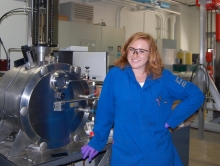
Major:
University:
Mentor(s):
Faculty Sponsor(s):
Faculty Sponsor's Department(s):
Project Title:
Project Description:
Thermoelectrics are materials that utilize a temperature gradient to convert heat to electricity, a viable method for recycling waste heat in places such as car exhausts. The efficiency of thermoelectrics is measured with a dimensionless quantity known as the thermoelectric figure of merit, ZT. ZT compares the Seebeck coefficient (S), electrical conductivity (σ), and thermal conductivity (κ) of the material; however, the electrical properties (S and σ) are highly contraindicated, making improvements to the ZT difficult. It has been shown that microstructural engineering can be used to increase phonon scattering, thereby decreasing κ and raising ZT without sacrificing optimal electrical properties. Semiconducting compounds with the Half-Heusler crystal structure (chemical formulas XYZ: XY-transition metals, Z-main-group element), such as TiNiSn, are already known to exhibit good electrical properties for thermoelectric generation, but have large κ. The addition of the full-Heusler (XY2Z) phase, TiNi2Sn, to the TiNiSn matrix by adding 10% excess Ni to form TiNi1.1Sn should increase phonon scattering by introducing phase boundaries. A series of heat treatments were performed to ensure full-Heusler incorporation; X-ray diffraction and scanning electron microscopy (SEM) were used to verify the presence of this phase in the material; room temperature measurements of S, σ, and κ were taken using the ZEM and physical property measuring system, PPMS, to calculate ZT. Following a high-temperature anneal, the thermal conductivity of TiNi1.1Sn decreased from ~4Wm-1K-1 to ~2Wm-1K-1 and the resultant ZT was approximately 0.25. Further heat treatments to evenly disperse Ni atoms throughout the material were shown to alter the physical properties as well and a deeper study into this phenomenon will be necessary in the future.
